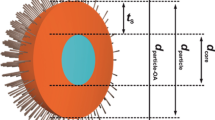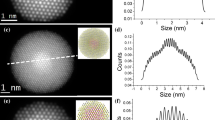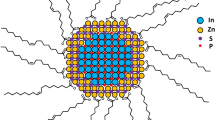Abstract
The size (hydrodynamic or Stokes radius, R H) of non-functionalized CdSeS/ZnS (core/shell) quantum dots (QDs) was characterized by size-exclusion chromatography with on-line quasi-elastic light scattering (SEC/QELS). Accurate determination of the size of QDs is important, because many of the optical properties of these materials are size dependent. A clear advantage of SEC/QELS over many batch techniques (e.g., QELS without separation) is the capability of the hyphenated technique to characterize the entire size range of a disperse sample, rather than merely providing a statistical average of the sizes present. Here, the SEC/QELS-determined R H values of CdSeS/ZnS QDs are compared to those determined by a traditional SEC experiment employing a calibration curve based on polystyrene standards, providing for the first reported study on SEC/QELS of non-functionalized QDs while also demonstrating the shortcomings of the widely-employed calibration curve approach. Furthermore, combining the R H of the QDs obtained by SEC/QELS with core size measurements derived from transmission electron microscopy allowed further calculation of the size of the QDs’ coronas. The latter result was found to be in close agreement to the previously measured dimension of the main corona constituent, as well as with the calculated size of this constituent.




Similar content being viewed by others
References
Huang H, Zhu J. The electrochemical applications of quantum dots. Analyst. 2013;138:5855–65.
Vasudevan D, Gaddam RR, Trinchi A, et al. Core-shell quantum dots: properties and applications. J Alloys Compd. 2015;636:395–404.
Pitkänen L, Striegel AM. Size-exclusion chromatography of metal nanoparticles and quantum dots. Trends Anal Chem. 2015;in press.
Krueger KM, Al-Somali AM, Falkner JC, Colvin VL. Characterization of nanocrystalline CdSe by size exclusion chromatography. Anal Chem. 2005;77:3511–5.
Lee M, Chung WJ, Park SK, Kim M, Seo HS, Ju JJ. Structural and optical characterizations of multi-layered and multi-stacked PbSe quantum dots. Nanotechnology. 2005;16:1148–52.
Wilcoxon JP, Provencio PP. Chemical and optical properties of CdSe and CdSe/ZnS nanocrystals investigated using high-performance liquid chromatography. J Phys Chem B. 2005;109:13461–71.
Wilcoxon JP, Martin JE, Provencio P. Size distributions of gold nanoclusters studied by liquid chromatography. Langmuir. 2000;16:9912–20.
Fischer CH, Weller H, Katsikas L, Henglein A. Photochemistry of colloidal semiconductors. 30. HPLC investigation of small CdS particles. Langmuir. 1989;5:429–32.
Trapiella-Alfonso L, Bustos ARM, Encinar JR, Costa-Fernandez JM, Pereiro R, Sanz-Medel A. New integrated elemental and molecular strategies as a diagnostic tool for the quality of water soluble quantum dots and their bioconjugates. Nanoscale. 2011;3:954–7.
Striegel AM, Yau WW, Kirkland JJ, Bly DD. Modern size-exclusion liquid chromatography. 2nd ed. Hoboken: Wiley; 2009.
Berne BJ, Pecora R. Dynamic light scattering. Mineola: Dover; 2000.
Johnson Jr CS, Gabriel DA. Laser light scattering. Mineola: Dover; 1981.
Brewer AK, Striegel AM. Characterizing the size, shape, and compactness of a polydisperse prolate ellipsoidal particle via quadruple-detector hydrodynamic chromatography. Analyst. 2011;136:515–9.
Brewer AK, Striegel AM. Characterizing a spheroidal nanocage drug delivery vesicle using multi-detector hydrodynamic chromatography. Anal Bioanal Chem. 2011;399:1507–14.
Brewer AK, Striegel AM. Characterizing string-of-pearls colloidal silica by multidetector hydrodynamic chromatography and comparison to multidetector size-exclusion chromatography, off-line multiangle static light scattering, and transmission electron microscopy. Anal Chem. 2011;83:3068–74.
Wyatt PJ. Light scattering and the absolute characterization of macromolecules. Anal Chim Acta. 1993;272:1–40.
Fetters LJ, Hadjichristidis N, Lindner JS, Mays JW. Molecular weight dependence of hydrodynamic and thermodynamic properties for well-defined linear polymers in solution. J Phys Chem Ref Data. 1994;23:619–40.
Abràmoff MD, Magalhães PJ, Ram SJ. Image processing with ImageJ. Biophoton Int. 2004;11:36–41.
Schneider CA, Rasband WS, Eliceiri KW. NIH image to ImageJ: 25 years of image analysis. Nat Methods. 2012;9:671–5.
Burchard W. Solution properties of branched macromolecules. Adv Polym Sci. 1999;143:113–94.
Krueger KM, Al-Somali AM, Mejia M, Colvin VL. The hydrodynamic size of polymer stabilized nanocrystals. Nanotechnology. 2007;18:475709/1–7.
Sander LC, Glinka CJ, Wise SA. Determination of bonded phase thickness in liquid chromatography by small angle neutron scattering. Anal Chem. 1990;62:1099–101.
Hiemenz P, Lodge T. Polymer chemistry. 2nd ed. Boca Raton: CRC Press; 2007.
Harris DC. Quantitative chemical analysis. 8th ed. New York: WH Freeman; 2010.
Acknowledgments
The authors are grateful to Liz Nguyen for her help with the TEM measurement.
Disclaimer
Commercial products are identified to specify adequately the experimental procedure. Such identification does not imply endorsement or recommendation by the National Institute of Standards and Technology, nor does it imply that the materials identified are necessarily the best available for the purpose.
Author information
Authors and Affiliations
Corresponding author
Ethics declarations
Conflict of interest
The authors have no conflict of interest to report.
Rights and permissions
About this article
Cite this article
Pitkänen, L., Striegel, A.M. Determining the core, corona, and total size of CdSeS/ZnS quantum dots by SEC/QELS and TEM. Anal Bioanal Chem 408, 4003–4010 (2016). https://doi.org/10.1007/s00216-016-9487-y
Received:
Revised:
Accepted:
Published:
Issue Date:
DOI: https://doi.org/10.1007/s00216-016-9487-y




